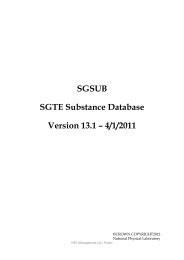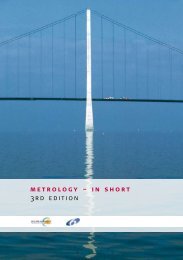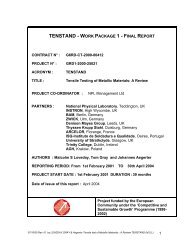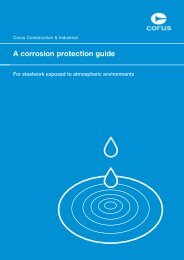Measuring colour appearance of red wines. - National Physical ...
Measuring colour appearance of red wines. - National Physical ...
Measuring colour appearance of red wines. - National Physical ...
Create successful ePaper yourself
Turn your PDF publications into a flip-book with our unique Google optimized e-Paper software.
NPL Optical Radiation Measurement Club<br />
Optical Technologies and Measurement Network<br />
Annual Meeting<br />
Digital Measurement<br />
<strong>of</strong> the <strong>appearance</strong> <strong>of</strong> <strong>red</strong><br />
wine – <strong>colour</strong> <strong>appearance</strong><br />
Wednesday 27th – Thursday 28th June 2007<br />
Globe Room, Bushy House, <strong>National</strong> <strong>Physical</strong> Laboratory
Martin, M.L.G.; Ji, W.; Luo, M.R.; Hutchings, J.; He<strong>red</strong>ia, F.J.<br />
(2007)<br />
<strong>Measuring</strong> <strong>colour</strong> <strong>appearance</strong> <strong>of</strong> <strong>red</strong> <strong>wines</strong>.<br />
Food Quality and Preference, 18, 862–871<br />
Department <strong>of</strong> Colour and Polymer Chemistry,<br />
University <strong>of</strong> Leeds, Leeds LS2 9JT, United Kingdom<br />
Laboratory <strong>of</strong> Food Colour and Quality, Department <strong>of</strong> Nutrition and<br />
Food Science,<br />
University <strong>of</strong> Seville, 41012 Sevilla, Spain
Aim:<br />
- To investigate the <strong>colour</strong> <strong>appearance</strong> <strong>of</strong> <strong>red</strong> <strong>wines</strong> in different<br />
depths,<br />
- To explore methods for quantifying the <strong>colour</strong> <strong>appearance</strong> <strong>of</strong> liquid<br />
foods,<br />
- To verify the Pridmore’s finding (2005) that perceived hue shifts<br />
from <strong>red</strong> at shallow to green at deep for some <strong>red</strong> <strong>wines</strong>.<br />
- To quantify the relationships between visual observations and<br />
physical measurements <strong>of</strong> <strong>colour</strong> for a series <strong>of</strong> <strong>wines</strong> with reference<br />
to the change <strong>of</strong> depth.
Four Wines: Table <strong>red</strong>, Oloroso,<br />
Tawny port and Rosé<br />
These four <strong>wines</strong> represent the <strong>colour</strong> range and<br />
characteristics <strong>of</strong> <strong>colour</strong> change <strong>of</strong> wine products.
Four Wines:<br />
These four <strong>wines</strong> were pou<strong>red</strong> into a Petri dish at<br />
different depths <strong>of</strong> 1.0, 2.5, 5.0, 7.5, 10.0 and 15.0 mm
Four Wines in :<br />
I II<br />
III<br />
1200 mm<br />
60°<br />
Φ 82 mm<br />
Φ7.5 mm<br />
870 mm<br />
1870 mm<br />
45°<br />
Φ7.5 mm<br />
The three regions <strong>of</strong> wine <strong>colour</strong> in the cocktail glass<br />
used for physical measurements and psychophysical<br />
experiments
<strong>Physical</strong> measurement<br />
Two instruments were used:<br />
- a Minolta CS1000 tele-spectroradiometer (TSR)<br />
and<br />
- a calibrated single-lens reflex digital camera (Nikon D1X)<br />
The measurement results were presented in CIECAM02<br />
lightness (J), <strong>colour</strong>fulness (M) and hue composition (H)<br />
(CIE, 2001).
• A VeriVide viewing cabinet with diffuse/0 geometry<br />
• A diffused D65 simulator<br />
• A GretagMacbeth ColourChecker DC chart was used<br />
for camera calibration.<br />
White backing<br />
Black backing<br />
Viewing windows<br />
Petri dish<br />
Camera
Visual assessment (magnitude estimation method)<br />
in terms <strong>of</strong> lightness, <strong>colour</strong>fulness and hue.<br />
•8 normal <strong>colour</strong> vision observers (Ishihara Test);<br />
•between 30 and 45 min for viewing;<br />
•3 females and 5 males;<br />
•aged between 24 and 41<br />
All observers had abundant experience in using magnitude estimation<br />
methodology but for most <strong>of</strong> them it was the first time estimating <strong>colour</strong><br />
<strong>appearance</strong> <strong>of</strong> wine samples.<br />
They were all research staff or research students either in the Department <strong>of</strong><br />
Colour Chemistry, University <strong>of</strong> Leeds (UK) or the Department <strong>of</strong> Food<br />
Science and Nutrition <strong>of</strong> University <strong>of</strong> Seville (Spain).<br />
The whole experiment was conducted at Leeds.
Wines<br />
(4 ×<br />
3 + 4 ×<br />
6 ) × 3 ×<br />
2 = 216<br />
×<br />
8 = 1728 observations
Lightness 100<br />
Colourfulness 40<br />
L* = 52<br />
a* = 31<br />
b* = 7<br />
Munsell<br />
four unique hues: <strong>red</strong>, yellow, green and blue<br />
10RP5/6
Results and discussion
Coefficient <strong>of</strong> Variation<br />
CV<br />
=<br />
Statistical Measures<br />
100×<br />
1<br />
N<br />
( Y − f × X )<br />
2 sets <strong>of</strong> data: CV =0% perfect agreement.<br />
Coefficient <strong>of</strong> determination<br />
N<br />
∑<br />
i=<br />
1<br />
CV = 30% 30% disagreement<br />
2<br />
n xy x y<br />
r<br />
[ ( ) ] [ ( ) ]<br />
2<br />
2 2<br />
2 ⎟ n x x n y y<br />
⎟<br />
⎛<br />
∑<br />
− ∑ ∑ ⎞<br />
= ⎜<br />
⎝ ∑ − ∑ ∑ − ∑ ⎠<br />
i<br />
Y<br />
i<br />
2<br />
i<br />
2
Mean (r2 / CV) Lightness Colourfulness Hue<br />
Observer<br />
accuracy<br />
0.88 / 17 0.67 / 37 0.99 / 10<br />
Observer<br />
Repeatability<br />
0.84 / 19 0.72 / 30 0.99 / 8<br />
• <strong>colour</strong>fulness is the worst performance;<br />
• changing in viewing and illumination for<br />
liquid sample;<br />
• repeatability > accuracy;<br />
• mean results were used.
Observer data<br />
b v<br />
10.0Y<br />
7.5Y<br />
100<br />
5.0Y<br />
80<br />
60<br />
40<br />
20<br />
1<br />
2.5Y<br />
2<br />
1<br />
3<br />
10.0YR<br />
2<br />
4<br />
5<br />
7.5YR<br />
5.0YR<br />
2.5YR<br />
10.0R<br />
5.0R<br />
2.5R<br />
10.0RP<br />
7.5RP<br />
0 1<br />
6 2 3 5<br />
5.0RP<br />
5 4 4 6<br />
-40 -20 0 20 40 60 80 100<br />
-20<br />
-40<br />
3<br />
2.5P<br />
6<br />
1<br />
3<br />
5.0P<br />
a v<br />
4<br />
2<br />
7.5P<br />
5<br />
6<br />
2.5RP<br />
10.0P<br />
7.5R<br />
Red<br />
Tawny<br />
Oloroso<br />
Rosé<br />
Lv<br />
100<br />
80<br />
60<br />
40<br />
20<br />
0<br />
1<br />
1<br />
1<br />
2<br />
2<br />
2<br />
1<br />
3<br />
4 5<br />
3 3<br />
4<br />
5 5 6<br />
6<br />
4<br />
6<br />
2<br />
6<br />
5 4<br />
Constant hue loci for Munsell<br />
Table <strong>red</strong>: depth ↑, lightness ↓, <strong>colour</strong>fulness ↑ then ↓, hue ≈<br />
Others: depth ↑, lightness ↓, <strong>colour</strong>fulness ↑ ,<br />
hue oloroso<br />
≈ 10YR-5RP, Rose<br />
3<br />
0 20 40 60 80<br />
Cv<br />
Value5<br />
2.5RP;<br />
≈ 2.5RP-5RP;<br />
tawny ≈ 7.5R-2.5R visually significant.<br />
Red<br />
Tawny<br />
Oloroso<br />
Rosé
What <strong>colour</strong> are they ???<br />
I II<br />
III
There is some visual evidence for a brownish green <strong>appearance</strong> <strong>of</strong><br />
the shallow oloroso (Pridmore et al., 2005).<br />
Two out <strong>of</strong> eight observers reported a slight green <strong>appearance</strong> but<br />
these were masked out when the panel averages were calculated.<br />
The effect to the naive wine observer, however, can vary amongst<br />
individuals, i.e. some viewers see the effect and some do not.<br />
Members <strong>of</strong> the sensory panel used in the experiment are experts in<br />
describing the <strong>colour</strong> <strong>appearance</strong> <strong>of</strong> opaque surface <strong>colour</strong>s. They<br />
are wine <strong>colour</strong> naive, presumably not expecting to see the counter<br />
intuitive green tinge in <strong>red</strong> wine.<br />
This sensory phenomenon requires attention in future work.
TSR<br />
b cc<br />
10.0Y<br />
7.5Y<br />
1<br />
100<br />
5.0Y<br />
80<br />
60<br />
40<br />
20<br />
2<br />
2.5Y<br />
10.0YR<br />
3<br />
1 2<br />
1<br />
2<br />
7.5YR<br />
5.0YR<br />
2.5YR<br />
10.0R<br />
5.0R<br />
2.5R<br />
10.0RP<br />
-40 -20<br />
0<br />
60<br />
20 40 4<br />
5<br />
60<br />
7.5RP<br />
5.0RP<br />
80 100<br />
-20<br />
-40<br />
5 4<br />
1<br />
2.5P<br />
4<br />
5<br />
6<br />
3<br />
3<br />
3 6<br />
5.0P<br />
a cc<br />
2<br />
7.5P<br />
5 4<br />
6<br />
2.5RP<br />
10.0P<br />
7.5R<br />
Red<br />
Tawny<br />
Oloroso<br />
Rosé<br />
Jcc<br />
100<br />
80<br />
60<br />
40<br />
20<br />
0<br />
1<br />
1<br />
1<br />
2<br />
6 5 4<br />
1<br />
2<br />
2<br />
3<br />
3<br />
6<br />
3<br />
3<br />
6<br />
5<br />
2<br />
4<br />
4<br />
4<br />
5<br />
0 20 40 60 80<br />
Mcc<br />
5<br />
6<br />
Red<br />
Tawny<br />
Oloroso<br />
Rosé<br />
similarity with observer results, except oloroso hue,<br />
a hue change from the greenish yellow Munsell 7.5GY (approximately hcc<br />
= 119, corresponding to Hcc = 132, i.e. 32% <strong>of</strong> yellow and 68% <strong>of</strong> green)<br />
to 7.5R as depth is increased. (see oloroso Point 1)<br />
This agrees with the results <strong>of</strong> the visual estimates <strong>of</strong> the smaller group <strong>of</strong><br />
panel members.<br />
The instrument detected the green hue effect.
cc<br />
TSR on cocktail glass at Regions I, II and III<br />
10.0Y<br />
100<br />
7.5Y 5.0Y<br />
80<br />
60<br />
40<br />
20<br />
2.5Y<br />
10.0YR<br />
7.5YR<br />
5.0YR<br />
2.5YR<br />
10.0R<br />
0<br />
7.5RP<br />
5.0RP<br />
-40 -20 0 20 40 60 80 100<br />
-20<br />
-40<br />
III<br />
I<br />
II<br />
III<br />
III<br />
2.5P<br />
II<br />
I<br />
I<br />
II<br />
5.0P<br />
acc<br />
I<br />
II III<br />
7.5P<br />
7.5R<br />
2.5RP<br />
10.0P<br />
5.0R<br />
2.5R<br />
10.0RP<br />
Red<br />
Tawny<br />
Oloroso<br />
Rosé<br />
Jcc<br />
100<br />
80<br />
60<br />
40<br />
20<br />
0<br />
III<br />
II<br />
I<br />
III<br />
III<br />
I<br />
I<br />
II<br />
II<br />
0 20 40 60 80<br />
Mcc<br />
I<br />
II<br />
III<br />
Red<br />
Tawny<br />
Oloroso<br />
Rosé
Digital Camera<br />
b cd<br />
10.0Y<br />
7.5Y<br />
100<br />
5.0Y<br />
1<br />
80<br />
60<br />
40<br />
20<br />
2.5Y<br />
1<br />
2<br />
10.0YR<br />
7.5YR<br />
5.0YR<br />
2.5YR<br />
10.0R<br />
-40 -20<br />
0<br />
0 20<br />
3<br />
40 60<br />
7.5RP<br />
5.0RP<br />
80 100<br />
-20<br />
-40<br />
2<br />
6<br />
2<br />
54<br />
5<br />
4<br />
3<br />
2.5P<br />
1<br />
3<br />
3<br />
5.0P<br />
a cd<br />
6<br />
4<br />
4<br />
7.5P<br />
5<br />
6<br />
5<br />
2<br />
6<br />
2.5RP<br />
10.0P<br />
7.5R<br />
5.0R<br />
2.5R<br />
10.0RP<br />
Red<br />
Tawny<br />
Oloroso<br />
Rosé<br />
Good agreement between TSR and Digital Camera<br />
100<br />
80<br />
60<br />
40<br />
20<br />
0<br />
1<br />
6<br />
1<br />
2<br />
1<br />
5<br />
2<br />
1<br />
4<br />
2<br />
3<br />
3<br />
3<br />
3<br />
4<br />
0 10 20 30 40 50 60 70 80<br />
The digital imaging measurements also show the greenish-yellow<br />
<strong>appearance</strong> (at 2.5GY in Munsell hue, and around 116 Hc value in<br />
CIECAM02 hue scale) for the shallow oloroso.<br />
Jcd<br />
5<br />
6<br />
Mcd<br />
4<br />
2<br />
5<br />
4<br />
6<br />
5<br />
6<br />
Red<br />
Tawny<br />
Oloroso<br />
Rosé
Compare<br />
results<br />
between:<br />
Visual,<br />
CS1000,<br />
and<br />
DigiEye<br />
Lv<br />
Lv<br />
L_CS1000<br />
100<br />
80<br />
60<br />
40<br />
20<br />
100<br />
80<br />
60<br />
40<br />
20<br />
100<br />
0<br />
0 20 40 60 80 100<br />
0<br />
0 20 40 60 80 100<br />
80<br />
60<br />
40<br />
20<br />
J_CS1000<br />
J_DigiEye<br />
0<br />
0 20 40 60 80 100<br />
J_DigiEye<br />
Cv<br />
Cv<br />
C_CS1000<br />
80<br />
60<br />
40<br />
20<br />
0<br />
0 20 40 60 80<br />
80<br />
60<br />
40<br />
20<br />
0<br />
0 20 40 60 80<br />
80<br />
60<br />
40<br />
20<br />
C_CS1000<br />
C_DigiEye<br />
0<br />
0 20 40 60 80<br />
C_DigiEye<br />
Hv<br />
Hv<br />
H_CS1000<br />
360<br />
300<br />
240<br />
180<br />
120<br />
60<br />
0<br />
360<br />
300<br />
240<br />
180<br />
120<br />
60<br />
0<br />
360<br />
300<br />
240<br />
180<br />
120<br />
60<br />
0<br />
0 60 120 180 240 300 360<br />
H_CS1000<br />
0 60 120 180 240 300 360<br />
H_DigiEye<br />
0 60 120 180 240 300 360<br />
H_DigiEye
Compare results between: Visual, CS1000, and DigiEye<br />
Observer vs. CS1000<br />
Observer vs. DigiEye<br />
CS1000 vs. DigiEye<br />
r 2 0.83<br />
CV 21<br />
r 2 0.84<br />
CV 20<br />
r 2 0.99<br />
Lightness<br />
Colourfulness<br />
0.87<br />
21<br />
0.89<br />
21<br />
0.90<br />
CV 5 19 5<br />
0.9 Hc<br />
0.98<br />
11<br />
0.98<br />
11<br />
0.99
Conclusions:<br />
1. A study has been carried out with measurements <strong>of</strong><br />
the <strong>colour</strong> <strong>appearance</strong> <strong>of</strong> different wine samples;<br />
2. observer accuracy and repeatability were conside<strong>red</strong> to<br />
be acceptable;<br />
3. The mean visual results from all observers were used in<br />
the following comparisons with instrumental method;<br />
4. Tele-spectroradiometer and digital camera results agreed<br />
well;<br />
5. Observer and physical measurements show good<br />
agreements for lightness and <strong>colour</strong>fulness;
Conclusions (continuous):<br />
6. For hue there was some discrepancy between observer<br />
data and physical measurement: greenish-yellow hue was<br />
reported;<br />
7. Instruments detected this greenish-yellow hue;<br />
8. All assessment and measurement methods successfully<br />
depicted the changes <strong>of</strong> <strong>colour</strong> that occur with depth;<br />
9. The use <strong>of</strong> <strong>colour</strong> <strong>appearance</strong> methodology represents a<br />
significant step forward in the study <strong>of</strong> <strong>wines</strong>;<br />
Finally, the digital non-contact method introduced here<br />
has many advantages for quantifying <strong>colour</strong> <strong>appearance</strong> <strong>of</strong><br />
liquid food products;








